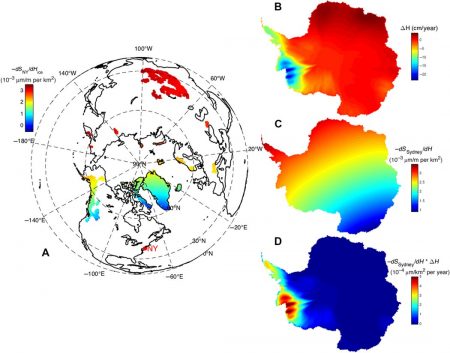November 16, 2017 – In the journal Science Advances, yesterday, researchers from the Jet Propulsion Laboratory (JPL), Caltech, in Pasadena, California, revealed a forecasting tool that shows which coastal cities are most at risk from land ice melt. The tool not only looks at the rate of melting from Greenland and Canada’s northern islands, Antarctica, and other continental ice sheets but also how Earth’s spin and gravitation impact the redistribution of ocean water globally.
The developed tool is built on a foundation of studying sea level rise through the 20th and first decades of the 21st century, plus the analysis of data from melting “outlet glaciers” on Greenland and Antarctica.
On a simpler level, one could assume that any significant loss of ice from an Antarctic continental ice sheet would have impacts on coastlines everywhere around the planet. But specific areas of these coastlines could be more at risk subject to Earth’s rotation, the vertical motion of the crust after the ice melts, and gravitational perturbations from the latter. The researchers, therefore, combined seismology, meteorology, and oceanography, and created an Ice Sheet System Model (ISSM) to develop projections of sea level rise at major port cities across the globe.
How do these scientists know?
First, there is gravity which is impacted by massive amounts of ice lying on the Earth’s surface. The weight of continental ice sheets pulls ocean water towards them. When the continental ice melts, ocean water moves away from their mass. And as the ice mass melts, groundwater sources compressed beneath the ice masses come into play expanding and moving upward to add to ocean volume.
Second, there is the rotation of the Earth which includes a wobble. That wobble is similar to what you see when you spin a top. Because of slight imperfections in the manufacturing most tops never spin perfectly evenly. There’s almost always a bit of a wobble. And that is true of the Earth when it spins.
In the case of the Earth, it is the location and mass of the continents, and the distribution of ocean water, that are contributors to its wobble. The continents’ mass can be altered when ice sheets melt. That in turn alters the ocean mass. The combination of the two change the wobble.
With the two phenomena mapped and added to observations in sea level changes and rates of ice melt from data collected throughout the 20th century and the beginning of the 21st, the JPL/Caltech scientists conceived ISSM to build city-specific forecasts for sea level rise. Some examples of observed correlation are provided below:
- Sea levels for the port of London, in the United Kingdom, correlate to melting of northwestern Greenland’s land ice.
- New York City’s port sea levels are linked to melting of ice sheets in northern and eastern Greenland.
- And Sydney, Australia, is impacted by melting of continental ice sheets in northern and northeastern Antarctica.
States Erik Ivins, one of the senior researchers and co-authors of the study,
“As cities and countries attempt to build plans to mitigate flooding, they have to be thinking about 100 years in the future and they want to assess risk in the same way that insurance companies do.”
Combining all of these complex processes ISSM may become very useful for cities along coastlines around the world in preparing to adapt to changes in local sea levels that could impact them noticeably as early as century end.











